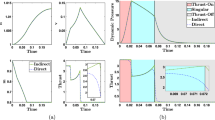Abstract
In this paper we study optimal control problems with the control variable appearing linearly. A novel method for optimization with respect to the switching times of controls containing both bang-bang and singular arcs is presented. This method transforms the control problem into a finite-dimensional optimization problem by reformulating the control problem as a multi-stage optimization problem. The optimal control problem is partitioned as several stages, with each stage corresponding to a particular control arc. A control vector parameterization approach is applied to convert the control problem to a static nonlinear programming (NLP) problem. The control profiles and stage lengths act as decision variables. Based on the Pontryagin maximal principle, a multi-stage adjoint system is constructed to calculate the gradients required by the NLP solvers. Two examples are studied to demonstrate the effectiveness of this strategy.
Similar content being viewed by others
References
A. A. Agrachev, G. Stefani, P. L. Zezza. Strong optimality for a bangbang trajectory. SIAM Journal of Control and Optimization, 2002, 41(4): 991–1014.
H. Maurer, C. Buskens, J. H. R. Kim, et al. Optimization methods for the verification of second order sufficient conditions for bang-bang controls. Optimal Control Applications and Methods, 2005, 26(1): 129–156.
G. Vossen. Switching time optimization for bang-bang and singular controls: variational derivatives and applications. Technical Report, Lehrund Forschungsanstalt fr Nichtlineare Dynamik, RWTH Aachen. Online: http://www.nld.rwth-aachen.de/de/139474.html.
J. R. Banga, E. Balsa-Canto, C. G. Moles, et al. Dynamic optimization of bioprocesses: Efficient and robust numerical strategies. Journal of Biotechnology, 2005, 117(4): 407–419.
W. Skolpap, J. M. Scharer, P. L. Douglas, et al. Fed-batch optimization of [alpha]-amylase and protease-producing Bacillus subtilis using genetic algorithm and particle swarm optimization. Chemical Engineering Science, 2008, 63(16): 4090–4099.
V. M. Zavala, A. F. Tlacuahuac, E. V. Lima. Dynamic optimization of a semi-batch reactor for polyurethane production. Chemical Engineering Science, 2005, 60(11): 3061–3079.
L. L. Simon, M. Introvigne, U. Fischer, et al. Batch reactor optimization under liquid swelling safety constraint. Chemical Engineering Science, 2008, 63(3): 770–781.
T. Binder, A. Cruse, C. A. Cruz Villar, et al. Dynamic optimization using a wavelet based adaptive control vector parameterization strategy. Computers and Chemical Engineering, 2000, 24(2/7): 1201–1207.
M. Schlegel, K. Stockmann, T. Binder, et al. Dynamic optimization using adaptive control vector parameterization. Computers and Chemical Engineering, 2005, 29(8): 1731–1751.
M. Schlegel, W. Marquardt. Adaptive switching structure detection for the solution of dynamic optimization problems. Industrial and Engineering Chemistry Research, 2006, 45(24): 8083–8094.
M. Schlegel, W. Marquardt. Detection and exploitation of the control switching structure in the solution of dynamic optimization problems. Journal of Process Control, 2006, 16(3): 275–290.
V. M. Zavala, R. Huang, L. T. Biegler. Simultaneous nonlinear programming strategies for nonlinear model predictive control applications: recent advances and future directions. Proceedings Foundations of Computer-Aided Process Operations. Cambridge, MA: Kluwer Academic Publisher, 2008.
C. Bskens, H. Maurer. SQP-methods for solving optimal control problems with control and state constraints: adjoint variables, sensitivity analysis and real-time control. Journal of Computational and Applied Mathematics, 2000, 120(1/2): 85–108.
A. Korytowski, M. Szymkat, H. Maurer, et al. Optimal control of a fedbatch fermentation process: numerical methods, sufficient conditions and sensitivity analysis. Proceedings of the 47th IEEE Conference on Decision and Control. Cancun, Mexiko: IEEE, 2008.
Author information
Authors and Affiliations
Corresponding author
Additional information
This work was supported by the Natural Science Foundation of China (No. 60974039) and the National Science and Technology Major Project (No. 2008ZX05011).
Shurong LI received his B.S. degree from Shandong University in 1987. He later obtained M.S. and Ph.D. degrees from the Institute of Systems Science at Chinese Academy of Sciences in 1990 and 1993, respectively. He finished his postdoctoral research at Tsinghua University in 1995. Currently, he is a professor of the China University of Petroleum (East China). His recent research interests include optimal control and optimization, nonlinear control, intelligent control.
Ruiyan ZHAO is a Ph.D. candidate at the College of Information and Control Engineering, China University of Petroleum (East China). His major research interests include optimal control theory and the related applications in reservoir recovery.
Qiang ZHANG is a Ph.D. candidate at the College of Information and Control Engineering, China University of Petroleum (East China). His major research interests include optimal control theory and the related applications in reservoir recovery and chemical engineering.
Rights and permissions
About this article
Cite this article
Li, S., Zhao, R. & Zhang, Q. Optimization method for solving bang-bang and singular control problems. J. Control Theory Appl. 10, 559–564 (2012). https://doi.org/10.1007/s11768-012-0276-7
Received:
Revised:
Published:
Issue Date:
DOI: https://doi.org/10.1007/s11768-012-0276-7




